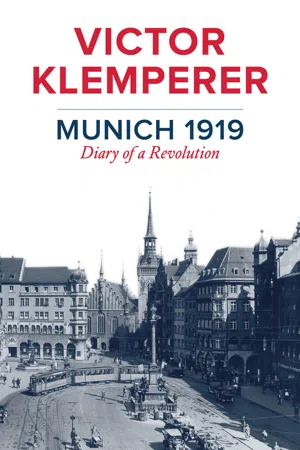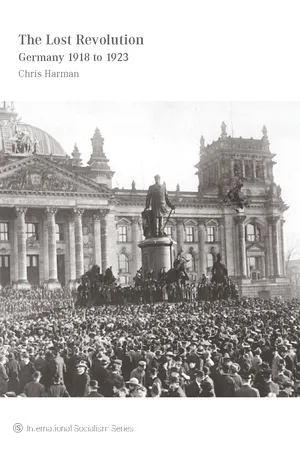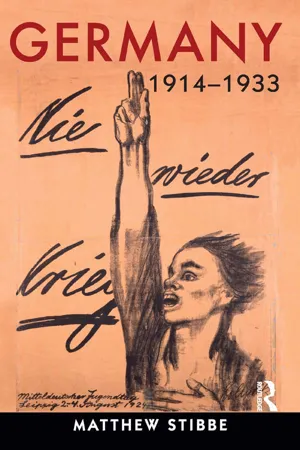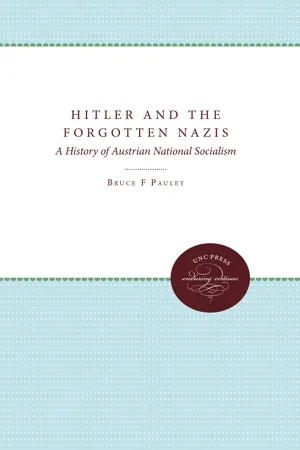History
Kapp Putsch
The Kapp Putsch was a failed coup attempt in 1920 in Germany, led by Wolfgang Kapp and supported by right-wing nationalist groups and the Freikorps. The coup aimed to overthrow the Weimar Republic and establish a right-wing government. Despite initial success, the coup collapsed due to a general strike by workers and lack of support from the military.
Written by Perlego with AI-assistance
Related key terms
Related key terms
1 of 4
Related key terms
1 of 3
7 Key excerpts on "Kapp Putsch"
- eBook - ePub
Munich 1919
Diary of a Revolution
- Victor Klemperer, Jessica Spengler(Authors)
- 2017(Publication Date)
- Polity(Publisher)
It was instigated by the reactionary East Prussian regional director-general Wolfgang Kapp and the highest-ranking officer in the Provisional Reichswehr, General Walther von Lüttwitz. For this reason, it is known as the Kapp-Lüttwitz Putsch. The Reich government, led by the Social Democrat Gustav Bauer, was forced to flee from Berlin to Stuttgart. Gustav Noske, who had lost political command of the military, had to vacate his post as Reich Minister of Defense. It took a general strike proclaimed by the unions and the political parties on the Left to fend off the putsch against the republic. But the nationalist Right had shown that it would not accept the defeat in the war, the “dictated peace” of the Treaty of Versailles, the forced disarmament or the democratization of politics. The opponents of the republic were bent on restoration and revenge. * Klemperer, who survived World War II with his wife Eva in a so-called “Judenhaus” (“Jews’ house”) in Dresden, and whose diaries have made him one of the most important chroniclers of Nazi Germany, had already foreseen in late April 1919 – in his report on “leftist” street fighters – the consequences of these political developments and radicalization in a way that was clear-sighted, if not downright prophetic, in light of the calamity to come: “While they may not yet have committed murder and not yet burned Munich to ashes, they have certainly not refrained from doing everything else that must inevitably wean the unrestrained mass from a sense of justice and gradually, ultimately, lead to the worst crimes - Barry A. Jackisch(Author)
- 2016(Publication Date)
- Routledge(Publisher)
106104 SGA, 19–20 June 1920, BARCH R8048/128, 8.105 Ibid.106 Ibid.Ultimately, the Kapp Putsch’s failure temporarily crushed any serious hopes that the Pan-German League might have held for an outright overthrow of the government during the Weimar Republic’s earliest years. The League had already made clear its fundamental opposition to the democratic system in its Bamberg Declaration, yet it now seemed that a forceful overthrow of the government would be almost impossible in the near future. The failure of Kapp’s poorly planned and executed Putsch greatly increased the national spotlight on all potentially dangerous anti-government, right-wing paramilitary activity.In fact, the Pan-German League itself came under increased surveillance by government security forces, and League members were forced to become more careful about their association with other illegal groups.107Furthermore, the embarrassing fallout from Kapp’s failed Putsch dealt a serious blow to the Pan-German League’s hopes for uniting all radical nationalist organizations against the Weimar Republic. As the next chapter will demonstrate, the Pan-Germans soon faced another major threat to their goal of a unified German Right in the League’s conflict with Reinhold Wulle, Albrecht von Graefe-Goldebee, General Erich Ludendorff, and the newly founded German Völkisch Freedom Party.107 The government’s focus on the Pan-German League’s activities in the period following the Kapp Putsch became very clear when at least three local and regional League chapters (Thuringia, Hamburg, Schaumberg-Lippe) were temporarily banned in the summer of 1922. According to official sources, the government suspected these chapters of various anti-government, right-wing activities and of a possible connection to Walther Rathenau’s recent assassination. The government later lifted these bans when it failed to produce sufficient evidence to support the allegations. For the government’s charges and the League’s response see: BARCH R8048/671, 94b–94d. On the government’s response to the German Right in the wake of the Rathenau murder generally see: Mommsen, Rise and Fall of Weimar Democracy, 126–128; and Sabrow, Die Verdrängte Verschwörung- eBook - ePub
The Radical Right in Germany
1870 to the Present
- Lee Mcgowan(Author)
- 2014(Publication Date)
- Routledge(Publisher)
This putsch represented the first serious attempt to overthrow the democratically elected government and was led by Wolfgang Kapp, formerly one of the leaders of the Fatherland party and garnered the sympathy of many representatives of the old right, including former high-ranking army officers such as Ludendorff, civil servants and DNVP deputies. Few of these, however, were prepared to risk their political future on so half-baked an adventure and the coup collapsed once it failed to secure a wider support base across the country and following a government-orchestrated general strike that paralysed Berlin. The episode is significant as it underscored the potential threat posed by the German right. The assertiveness of the far right was in evidence in many parts of Germany and particularly acute in Bavaria where, for example, the Bund Bayern und Reich (Bavaria and Reich League) placed growing pressure on the Bavarian authorities to resist compliance with Germany’s disarmament obligations and demanded the restoration of the Bavarian royal family and even contemplated the separation of Bavaria from the Reich until the threat posed by bolshevism had been countered. Their nationalist leanings were symptomatic of many right-wing groups and were reflected in a growing militancy that encapsulated the activities of groups such as the Bund Oberland which took part in fighting in the Ruhr and in Upper Silesia and assumed a new stage of escalation when the right-wing terrorist Organization Consul (which comprised mostly young and disaffected ex-officers) assassinated two of the Republic’s strongest advocates, namely the Centre Party politician, Matthias Erzberger (who had signed the Versailles Treaty on behalf of the German government), in August 1921 and Walther Rathenau, the Jewish-German Foreign Minister, in June 1922 - eBook - ePub
Battlegrounds: Cornell Studies in Military History
The Legend of Erich Ludendorff in the Weimar Republic and Third Reich
- Jay Lockenour(Author)
- 2021(Publication Date)
- Cornell University Press(Publisher)
138Many on the right, including Alfred von Tirpitz, considered the move ill-timed and poorly planned.139 Max Weber feared that the repercussions of the Kapp Putsch would lead to the dissolution of the Reich. In a letter to his sister in May 1920 he worried about Bavarian separatism and leftist uprisings, writing that “if the Reich breaks up, then it will have been the work of these people (Kapp, Lüttwitz, and I fear I must add Ludendorff).”140 When the putsch seemed likely to call forth the very leftist revolution it was supposed to prevent, most of its potential allies and friends deserted it.141Ludendorff found little sympathy in Berlin. Captain Ehrhardt posted a twenty-four-man bodyguard around Ludendorff’s house. He blamed the failure of the putsch on inadequate preparation and on the disloyal and selfish behavior of so many officers unwilling to follow Lüttwitz’s lead.142 Ludendorff fled at the end of March for the safety of Bavaria, where wealthy nationalists sheltered him, first in a castle overlooking the Inn Valley, then, near Rosenheim at the home of Baron von Halkett.143 In August of the same year, he rented a house overlooking the Isar River near Munich in Ludwigshöhe.144 The Munich Schutzpolizei provided Ludendorff with a car and an “adjutant” to accompany him as he traveled around the city.145Few of the main conspirators received any kind of punishment. Several were indicted but not tried. Lüttwitz found shelter in Silesia with friends. Kapp fled to Sweden, Bauer and Ehrhardt to Munich. Only Traugott von Jagow served any time.146 Ludendorff managed to avoid even the indictment for high treason that fell on Kapp, Bauer, and the others. The cabinet initially deemed it too dangerous to arrest Ludendorff. Seeckt agreed that for the sake of the troops—and because Ludendorff had not “actively participated”—his arrest was not necessary.147 Ludendorff’s reliance on Bauer as a go-between and his refusal to participate directly in the putschists’ activities allowed him to keep his freedom.148 - eBook - ePub
The Lost Revolution
Germany 1918 to 1923
- Chris Harman(Author)
- 2017(Publication Date)
- Haymarket Books(Publisher)
Yet overall, the right wing generals had prompted the beginnings of a new revolution in their efforts to bury the last remnants of the old. The situation was rather similar to that in Spain in July 1936, after Franco’s military uprising. The right wing army coup provoked a counter-rising of the workers. But this could not content itself with merely attacking the open supporters of the coup. The workers understood that if Kapp and Lüttwitz were successful, the rest of the military would soon swing behind them. The whole officer corps yearned for the days before the November Revolution, not just a few backwoodsmen.Many workers had opposed the Spartakists in January 1919, had stood back when the Freikorps marched into Berlin and Bremen, had considered the Ruhr strikers extremists, and had accepted the Social Democrats’ reasons for crushing the Bavarian Soviet Republic. Now they could see that not only the ‘extremists’, but they themselves were under attack, and they followed the call of local left Independents and Communists to destroy the power structure that had made the Kapp Putsch possible. In doing so they began to create new alternative power structures—structures of workers’ power—alongside the old.Within three or four days of the coup, the authority of the state no longer held sway in some of the main industrial centres of Germany. The military forces that had lorded over the country as they marched from one end to the other in 1919, had suffered defeat in battle. They began to lose all confidence once they faced, not one section of workers fighting while another section a few miles away stood back, but simultaneous risings in many different places. What is more, the railway strike prevented them from moving fresh troops to aid besieged local garrisons.Kapp backs outIn Berlin Kapp’s supporters found themselves in a bewildering position. They had carried through a highly effective military coup: in military terms it was not a putsch, a failure, but a very successful operation. Half the army was supporting them and the other half was merely waiting to make sure the coup was a success before doing so. The right wing parties recognised their rule. - eBook - ePub
Germany, 1914-1933
Politics, Society and Culture
- Matthew Stibbe(Author)
- 2013(Publication Date)
- Routledge(Publisher)
73One individual who arrived in Berlin too late to witness the end of the Kapp Putsch in 1920 was Adolf Hitler, then a part-time soldier and leader of a new radical right-wing party in Munich, the National Socialist German Workers’ Party (NSDAP). Significantly, Hitler was sent to Berlin, together with his party colleague Dietrich Eckart, by his former boss in the intelligence branch of the Bavarian army, Captain Mayr, to inform Kapp of the developing situation in Bavaria.74 Here, under the cover of the Kapp Putsch, a new authoritarian government had also been installed under Gustav Ritter von Kahr, who was something of an old-fashioned Bavarian separatist with strong anti-republican and anti-socialist leanings. Henceforth Bavaria was to become a stronghold of right-wing reaction in Germany, and a haven for extremists on the run from the police in social democratic Prussia in the north.75Hitler himself left the army at the end of March 1920 to embark on a full-time career as a political agitator. His chief asset was his gifts as a speaker, which enabled the party to attract hundreds of new recruits in the beer halls of Munich in the early 1920s.76 But even then, the National Socialists were just one of many far-right groupings and individuals in Bavaria at this time. Other influential organisations included the rabidly anti-Semitic Germanenorden , the occultist Thule Society and the Aufbau circle, made up of White Russian and Baltic German emigrés who had fled their homes in the aftermath of the Bolshevik revolution.77 What distinguished these groups from other nationalist parties, and from the Reichswehr, was their belief in a ‘Judeo-Bolshevik’ world conspiracy, and their desire to destroy not only the ‘Versailles system’ and the ‘Marxist’ Weimar Republic, but also the Soviet Union, whose lands and territories would become new ‘living space’ for future generations of ‘Aryan’ Germans.78 Calling themselves the Deutscher Kampfbund (‘German combat league’) these different bodies and individuals came together in November 1923 to take part in a violent attempt to overthrow the government of Bavaria, for which Hitler, as one of the putsch’s leaders, received a short jail sentence. Ludendorff, the other key conspirator, was acquitted.79 - eBook - ePub
Hitler and the Forgotten Nazis
A History of Austrian National Socialism
- Bruce F. Pauley(Author)
- 2017(Publication Date)
- The University of North Carolina Press(Publisher)
14 Some of it was directed against public buildings, barracks, prisons, and other government buildings as well as against judges, police officials, and politicians. Most explosions, however, occurred near tourist areas, waterworks, and power plants.It is impossible to say who was responsible for this complete collapse of the “evolutionary” policy initiated in March. As the leader of the Austrian party, however, it was Theo Habicht who bore the ultimate obligation to control these activities. The consequences of the party’s reckless defiance of international law were the diplomatic isolation of Germany and the near destruction of the party itself.The climax of the new wave of terror came early in the afternoon of 25 July when 154 members of the Viennese SS Standarte Eighty-nine, disguised in uniforms of the Austrian army, broke into the federal chancellery on the Ballhausplatz in Vienna and mortally wounded Engelbert Dollfuss. This act was just the beginning of the notorious July Putsch, which ended three days later after 153 Nazis had been killed in battle (or later executed) and thousands more had fled to Germany and Yugoslavia.The story of the Putsch, which has been told and retold in almost excruciating detail, need not be repeated here. Still of interest, however, is what induced the Austrian Nazis to take this desperate gamble, why the action misfired, and what impact its failure had on the subsequent history of the illegal party.The idea of a Putsch was an old one. The first rumors of a plot to overthrow the government reached the German Legation in Vienna on 26 July 1933, only five weeks after the party had been outlawed. This plan, to be carried out in September, was never implemented. The SA also began to work on Putsch plans during the summer, which led to conversations in October between Ernst Röhm, Hermann Reschny (the leader of the Austrian SA), Habicht, and Proksch. At a meeting in Passau the conspirators agreed that the Putsch should take place on 9 November (the tenth anniversary of the Beer Hall Putsch). It was supposed to begin in the Nazi stronghold of Carinthia and lead to a nationwide strike. A lack of weapons in Carinthia, however, prevented the execution of this plan.15
Index pages curate the most relevant extracts from our library of academic textbooks. They’ve been created using an in-house natural language model (NLM), each adding context and meaning to key research topics.
Explore more topic indexes
Explore more topic indexes
1 of 6
Explore more topic indexes
1 of 4






